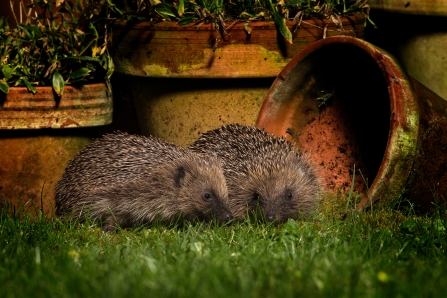4 minute read
Or, you can listen to the full conversation on The Wild Cornwall Podcast.
Hedgehog by Tom Marshall
4 minute read
Or, you can listen to the full conversation on The Wild Cornwall Podcast.
I basically do a little bit of everything. My main role is focusing on Operation Hedgehog, but I also get involved in other projects, with badgers, beavers, and a little bit of dormice work. I'm absolutely loving it: I love absorbing all sorts of information.
It’s definitely teaching people that it doesn't take that much to make a massive impact on wildlife. People think that they have to do some massive change, but all it takes is something small, like making a bug hotel or creating wild areas in your garden. Those things can have a massive impact.
Operation Hedgehog is a collaboration between Cornwall Wildlife Trust, Prickles and Paws, the University of Exeter, and Cornwall Mammal Group. It was started after hedgehogs were classified on the Red List, which means they are vulnerable for British mammals. That means they could potentially go extinct… So it was set up because we knew that hedgehogs had been declining massively for years.
Hedgehogs are elusive, so we don't really know their exact numbers. We’re guessing there are around a million or even less in the UK now. But back in the 1970s there was more like 36 million. So, Operation Hedgehog is all about surveying them to figure out where they are and why they're in those places. It’s also about getting involved with landowners and developers so that they can create land which will be helpful for hedgehogs in the future. We also want to encourage members of the public to get involved, learn more about hedgehogs and find out what they can do.

© Jon Hawkins
Originally, they were actually called urchins, which led to the naming of sea urchins because we thought they looked like hedgehogs. Over time the name changed to hedgehog because they were always found near hedgerows. And they also are quite noisy animals. A lot of people don't realize this, but they do make a lot of grunting noises similar to pigs – and that ended up leading to their name ‘hog’.
A lot of people don't really realise that they're endangered in the first place. That’s really worrying: they’re really not doing so great. Hedgehogs are known as an indicator species: they let us know when the habitat is healthy. If there's a hedgehog about, we know that that area is healthy: there's enough food for everything and enough vegetation. In addition to that, they also manage pests and insects as well. They can get rid of those slugs and snails in your garden!
Pretty much anything! They're opportunistic omnivores, like badgers.
They are mammals, but they're in the rodent family. Their skeletons are actually very similar to rats, which we don't really see because they're just a ball of spines.
The average adult has between 5,000 to 7,000 spines. Someone must have spent a long day counting! They're basically fortified hairs, which keep them protected. Hedgehogs lack a flight and fight instinct: if they get scared, they don't run away or attack, they just curl up into their ball, which is the way they've got the spines to protect them from potentially being eaten.
Hedgehogs love areas of scrub: brambles bushes, woodland edges, hedgerows… anywhere they can get lost and avoid as much predation as possible.
It's hard to pinpoint one cause because it's a combination of factors. Intensive farming is one reason, the traffic on our roads, and the way in which we garden. We’re finding that they're more common in urban and suburban landscapes than they are in rural areas due to farming. So they're coming into our gardens, but a lot of people now have quite sterile gardens where it's very clean cut, and which is not great for them. They need lots of areas to hide…
There's lots of things you can do. If you do like your garden being a bit more tidy, you can just leave one little corner to be a bit more wild. You could leave out hedgehog boxes, which you can build yourself or buy one.
You can also use alternatives to chemical pesticides – they’re one of the main issues that they face because the use of pesticides means there's not enough food for them. You can use alternatives like salt, seaweed, or coffee grounds.
Another way is encouraging the connectivity between environments. You can cut a little 13 by 13cm hole in your fence. This will allow hedgehogs to pass in and out of your garden safely.